Chemical weed control
What is Chemical or Herbicide Weed Control?
In chemical weed control, chemicals called herbicides are used to kill certain plants or inhibit their growth. Chemical weed control is an option in integrated weed management that refers to the integrated use of cultural, manual, mechanical and/or chemical control methods.
 Why Control Weeds?
Why Control Weeds?
- Prevent yield loss due to weed competition
- Maintain purity and/or quality and market price of harvested grain
- Prevent build-up of weed seeds in soil
- Prevent weeds that may attract insects or rodents (rats) or act as a host for diseases
- Prevent clogging of field irrigation channels and facilitate water flow
- Reduce time and cost of land preparation and weeding operations
Why Use Herbicides to Control Weeds?
- Less labor (0.5 person-day per ha per application) and less drudgery
- Cost-effective, if practiced properly
- No need to wait for weeds to grow bigger for hand weeding
- Herbicides can differentitate between rice and weeds, even at seedling stage where it is very difficult for people to see the difference
How to Use Herbicides to Effectively Control Weeds?
- Weeds need to be controlled from planting until the crop canopy closes.
- ALWAYS READ and FOLLOW the instructions on the product label.
- Ensure the product is suited for the type and stage of crop and weeds to be controlled.
- Ensure field conditions are suitable (e.g., some products only work when the soil is moist, or when there is standing water or no standing water).
- Products are designed for early application when weed control is most important. Some products are designed to control the weeds before they emerge (pre-emergence), while others are only effective after the weeds have emerged (post-emergence).
- Use the recommended rate of water.
- Use clean water, fresh water
- Uniformly apply product across the field: maintain steady pressure, a steady walking speed and uniform spray application action.
- Ensure nozzles are functioning and providing uniform output.
- Spray products from a height of around 50 cm above the target.
- Minimize movement of the product to non-target areas by using low pressures (< 2 bars), by avoiding applications in very strong winds and by limiting water run-off from fields.
- Spray perpendicular to the wind, so that product is blown away from the applicator.
- Be sure to rotate the use of herbicides so weeds do not develop resistance
Limitations of Chemical/Herbicide Weed Control
- Herbicides are toxic substances, which if used unwisely or incorrectly can cause health and environment problems.
- Herbicides are often weed-specific
- Weeds can develop herbicide resistance if farmers are too reliant on one type of herbicide
- Drift risk to neighbors crop
- Applicators require skills in application and calibration
Safety Considerations
- ALWAYS WEAR PROTECTIVE EQUIPMENT. Use appropriate cover for head, eyes, nose, mouth and hands. Wear long sleeved shirts, long pants and covered footwear.
- Mixing product is the time of greatest concern as the product is in its most concentrated form.
- When mixing the product, always stand upwind and wear protective clothing – especially face protection.
- Wash contaminated cloths separately from other household cloths.
- Clean blocked nozzles with a non-abrasive implement. NEVER clean nozzles by blowing on them with the mouth.
- Discard containers properly
Developed with input from B Chauhan, MA Bell, JF Rickman, and V Balasubramanian.







